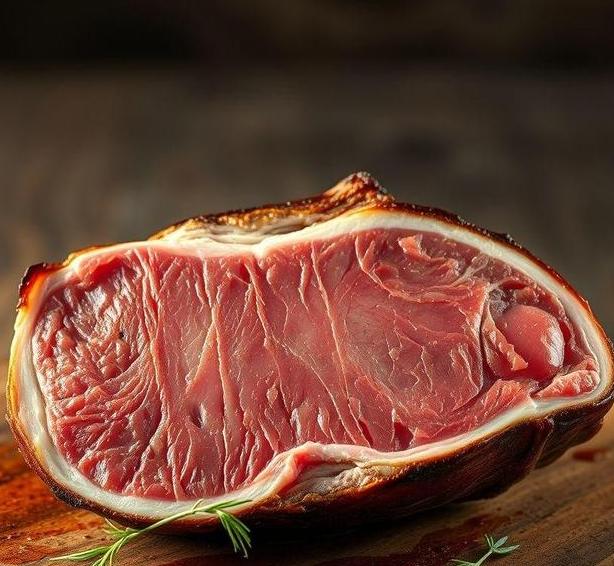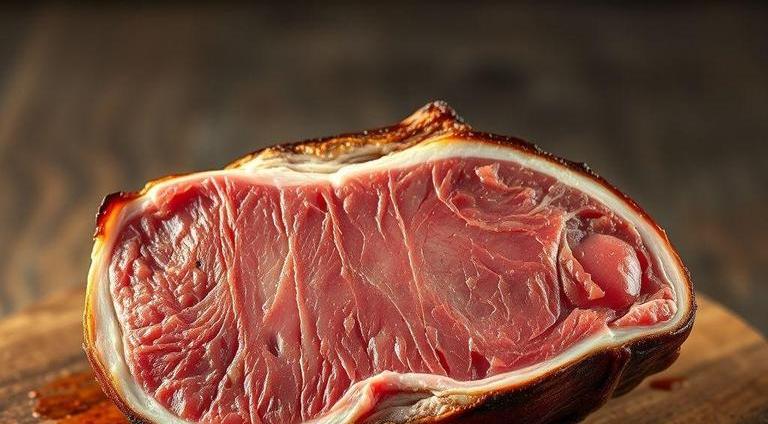Can Half Meat Go Bad : What You MUST Know
When it comes to food preservation, half meat refers to meat that’s been partially preserved, often through methods like curing, smoking, or drying. This technique allows meat to last longer than fresh cuts, making it a popular choice for people who enjoy stocking up or don’t have immediate plans to cook all of their meat.
But just like any food, there’s always a concern about whether it can spoil, how long it stays fresh, and what happens if you eat something past its prime. So, in this post, we’re going to dive deep into the world of half meat, answer your burning questions, and give you a comprehensive understanding of how to keep it safe to eat for as long as possible. This is more than just about checking the expiration date-it’s about knowing how to care for half meat like a pro.
Can Half Meat Go Bad?
Yes, half meat can go bad, even though the preservation methods it undergoes (like curing, drying, or smoking) generally make it more resilient than regular fresh meat. That said, no preservation method is foolproof, and all food has a lifespan, including half meat. Whether you’re dealing with ham, bacon, sausage, or other types of preserved meats, improper handling or storage can lead to spoilage.
Let’s break it down:
- Preservation Does Not Equal Perfection: While curing or smoking reduces bacterial growth, it doesn’t completely stop it. Over time, exposure to air, temperature fluctuations, and moisture can encourage bacteria to grow, especially on the surface of the meat.
- Meat Still Contains Moisture: Even though the meat is partially dried or cured, it still retains some moisture, which is a perfect breeding ground for spoilage organisms like mold or yeast if not stored properly.
- The Type of Meat Matters: Some types of half meat (like prosciutto) are drier and last longer, while others (like sausages) have more moisture and spoil more quickly.
Shelf Life For Half Meat

The shelf life of half meat varies depending on how it’s prepared and stored. Here’s a detailed look at some popular types of half meat and their expected shelf life:
Cured Meats (Ham, Bacon, Salami)
- Unopened, refrigerated: 2-3 weeks after the ’sell by’ date.
- Opened, refrigerated: 7-10 days.
- Frozen: Up to 6 months, though quality may start to decline after 1-2 months.
Dry-Cured Meats (Prosciutto, Bresaola, Coppa)
- Unopened, room temperature: These can last 6-12 months if properly stored in a cool, dry place.
- Opened, room temperature: Once you break the seal, it’s best to consume it within 1-2 weeks.
- Refrigerated (opened): 2-3 weeks. The cooler the temperature, the longer it stays good.
Sausages (Summer Sausage, Salami)
- Unopened, refrigerated: 2-3 weeks.
- Opened, refrigerated: 7-10 days.
- Frozen: 1-2 months for best quality.
Jerky
- Unopened, room temperature: Up to 6 months.
- Opened, room temperature: 1-2 months.
- Refrigerated: Jerky can last up to a year or more when stored in a vacuum-sealed bag or airtight container.
These are general guidelines, but the shelf life of half meat is heavily influenced by storage conditions and the type of preservation.
Common Signs Of Spoilage
If you’re unsure whether your half meat is still safe to eat, here are the most common signs to look out for:
Off Smell
- Fresh half meat usually has a savory, smoky, or slightly tangy scent depending on its curing process. If it smells sour, rotten, or off in any way, it’s a clear indication that it’s no longer good to eat.
Discoloration
- While some variation in color is normal due to the curing or drying process, any noticeable green, black, or slimy spots are a sign of spoilage. Some discoloration (like darkening around the edges) is normal, but when it turns green or grey, toss it out.
Slimy Texture
- A slimy or sticky surface means bacteria or mold may be growing on the meat. The meat should feel firm and dry, not slippery.
Mold
- While some types of half meat (like dry-cured sausages) may naturally develop a white powdery coating of mold (which is safe), anything green, blue, or black is a clear sign of contamination.
Visible Leaks Or Excess Moisture
- If there’s an abnormal amount of moisture or the meat looks wet and soggy, it could be a sign that the packaging has been compromised, or it’s been improperly stored.
How To Store Half Meat?

Storing half meat properly is crucial to ensuring it lasts as long as possible without spoiling. Let’s talk about the best practices for storage.
Refrigeration Vs. Freezing
- Refrigeration: For half meats that need to be consumed sooner, store them in the coldest part of your refrigerator (typically near the back or on a bottom shelf). Be sure to keep them in airtight packaging to prevent exposure to air, which speeds up spoilage.
- Freezing: Freezing is a great option for preserving half meat if you don’t think you’ll finish it in time. Wrap it tightly in plastic wrap or vacuum-sealed bags to protect it from freezer burn.
Use Airtight Packaging
- Vacuum-sealing is one of the best methods to preserve half meat. If you don’t have a vacuum sealer, wrap the meat tightly in plastic wrap, then place it in a resealable plastic bag or an airtight container.
Keep It Cool And Dry
- For dried meats (like jerky, salami, or prosciutto), they can often be stored at room temperature in a cool, dry place, away from direct sunlight. Ideally, keep them in a paper bag, as this allows the meat to breathe and maintain its flavor.
Avoid Cross-Contamination
- Always ensure the storage container or wrapping is clean, and avoid touching the meat with dirty hands or utensils. Cross-contamination can lead to faster spoilage.
Expert Tips
If you want your half meat to last even longer and retain its quality, here are some expert tips:
- Know Your Meat: Different half meats have different preservation needs. Be aware of the characteristics of the specific type you’re storing and adjust your approach accordingly.
- Use The “First In, First Out” Method: When you buy new half meat, always use older stock first. This way, you’re minimizing the risk of something spoiling before it’s eaten.
- Avoid Frequent Temperature Changes: Each time you take the meat in and out of the fridge, it’s exposed to temperature fluctuations that can accelerate spoilage. Keep it stored consistently.
- Label and Date Your Meat: If you freeze half meat, label it with the date it was stored so you can track how long it’s been in the freezer. This helps ensure you use it before its quality starts to decline.
FAQs
Can Half-eaten Meat Go Bad?
Yes, half-eaten meat can go bad, especially if it is not properly stored. Leftover meat should be refrigerated or frozen within two hours of consumption to prevent bacterial growth and spoilage.
How Long Does Half-eaten Cooked Meat Last In The Fridge?
Cooked meat that has been properly stored in an airtight container can last in the fridge for 3 to 4 days. After that, it should be discarded to avoid foodborne illness.
Can Half-frozen Meat Go Bad?
If meat has been partially thawed and then refrozen, it can deteriorate in quality and texture. It can still be safe to eat if it has been kept at a consistent low temperature, but it’s best consumed quickly to prevent spoilage.
What Temperature Should Half-eaten Meat Be Stored At?
Half-eaten meat should be stored at or below 40°F (4°C) in the refrigerator. If you need to store it longer, freezing the meat at 0°F (-18°C) is the best option.
How Can You Tell If Half-eaten Meat Has Gone Bad?
Signs that meat has gone bad include a sour or off odor, a slimy texture, and a change in color, such as turning gray or green. If the meat looks or smells unusual, it’s best to discard it.
Can Half-eaten Raw Meat Go Bad Faster Than Cooked Meat?
Yes, raw meat tends to spoil faster than cooked meat because it contains more moisture and has not undergone any heat treatment to kill harmful bacteria. It should be cooked or frozen as soon as possible.
Is It Safe To Eat Meat After 3 Days In The Fridge?
Meat that has been stored for 3 days in the fridge is generally safe to eat, provided it has been properly handled and stored at the correct temperature. However, if there is any doubt about its safety, it is better to discard it.
How Do I Store Half-eaten Meat To Prevent It From Going Bad?
Store half-eaten meat in an airtight container or wrap it tightly in plastic wrap or aluminum foil. Make sure to refrigerate it within two hours of eating and consume it within 3 to 4 days.
Can Half-eaten Meat Be Reheated Safely?
Yes, half-eaten meat can be safely reheated if it has been properly stored in the fridge. Reheat it to a minimum internal temperature of 165°F (74°C) to kill any potential bacteria.
How Long Can Half-eaten Meat Last In The Freezer?
Frozen cooked meat can last 2 to 6 months in the freezer, while raw meat should be consumed within 4 to 12 months depending on the type. To maintain quality, wrap the meat tightly to prevent freezer burn.
